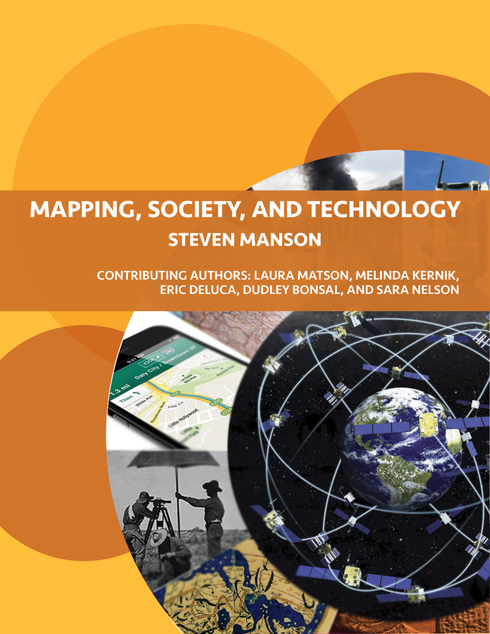 GIS fundamentals : a first text on geographic information systems
by
New and updated Sixth Edition of GIS Fundamentals, 6th Edition - the bestselling GIS textbook by Paul Bolstad.
Geographic Information Systems (GIS) are computer-based tools for the entry, maintenance, and analysis of spatial data. GIS are critical for effective resource management, and have been applied across a wide range of science, business, and government endeavours.
This book provides an introduction to the theory and application of GIS. It is written for use in a first-year GIS class and as a reference for the GIS practitioner. This sixth edition balances theoretical and practical material, so that students may apply knowledge of GIS in the solution of real-world problems. Improvements over the previous editions are included in each chapter. Topics treated include an introduction to GIS, spatial data models, map projections, data entry, image data, GPS, digital data, database systems in GIS, general spatial analysis, raster analysis, terrain modeling, metadata, standards, and accuracy assessments.
GIS fundamentals : a first text on geographic information systems
by
New and updated Sixth Edition of GIS Fundamentals, 6th Edition - the bestselling GIS textbook by Paul Bolstad.
Geographic Information Systems (GIS) are computer-based tools for the entry, maintenance, and analysis of spatial data. GIS are critical for effective resource management, and have been applied across a wide range of science, business, and government endeavours.
This book provides an introduction to the theory and application of GIS. It is written for use in a first-year GIS class and as a reference for the GIS practitioner. This sixth edition balances theoretical and practical material, so that students may apply knowledge of GIS in the solution of real-world problems. Improvements over the previous editions are included in each chapter. Topics treated include an introduction to GIS, spatial data models, map projections, data entry, image data, GPS, digital data, database systems in GIS, general spatial analysis, raster analysis, terrain modeling, metadata, standards, and accuracy assessments.
 DeLorme U.S. national atlas & gazetteer set
by
DeLorme Atlas & Gazetteers Are the Outdoor Enthusiasts' Choice
Amazingly detailed and beautifully crafted, large-format paper maps for all 50 states
Topographic maps with elevation contours, major highways and roads, dirt roads, trails and land use data
Gazetteer section contains information essential for any outdoor enthusiast, such as points of interest, landmarks, state and national parks, campgrounds, boat launches, golf courses, historic sites, hunting zones, canoe trips, scenic drive recommendations and more (Note: available information varies by state)
Perfect for sightseeing, exploring back roads, outdoor recreation and trip planning
The Perfect Companion for Outdoor Recreation and Trip Planning
Rely on DeLorme Atlas & Gazetteer paper maps for the utmost in trip planning and backcountry access. It's available in paperback (11-inches x 15.5-inches) for all 50 states.
DeLorme U.S. national atlas & gazetteer set
by
DeLorme Atlas & Gazetteers Are the Outdoor Enthusiasts' Choice
Amazingly detailed and beautifully crafted, large-format paper maps for all 50 states
Topographic maps with elevation contours, major highways and roads, dirt roads, trails and land use data
Gazetteer section contains information essential for any outdoor enthusiast, such as points of interest, landmarks, state and national parks, campgrounds, boat launches, golf courses, historic sites, hunting zones, canoe trips, scenic drive recommendations and more (Note: available information varies by state)
Perfect for sightseeing, exploring back roads, outdoor recreation and trip planning
The Perfect Companion for Outdoor Recreation and Trip Planning
Rely on DeLorme Atlas & Gazetteer paper maps for the utmost in trip planning and backcountry access. It's available in paperback (11-inches x 15.5-inches) for all 50 states.
 Drawing the line : tales of maps and cartocontroversy
by
Argues that maps can be manipulated to distort the truth, and shows how they have been used for propaganda in international affairs, political districting, and finding toxic dump sites.
Drawing the line : tales of maps and cartocontroversy
by
Argues that maps can be manipulated to distort the truth, and shows how they have been used for propaganda in international affairs, political districting, and finding toxic dump sites.
 Interpretation of Topographic Maps
by
Interpretation of Topographic Maps
by
 Map Index to Topographic Quadrangles of the United States, 1882-1940
by
For many years, coverage of large areas of the United States was done with maps at what are called smaller scales, such as the 15-minute series (one inch on the map represents about a mile). These are still useful for historical research and for looking at larger areas. This volume lists all of the U.S. Geological Survey's old 15-, 30-, and 60-minute quadrangles and has index maps showing what area each sheet covers.
Map Index to Topographic Quadrangles of the United States, 1882-1940
by
For many years, coverage of large areas of the United States was done with maps at what are called smaller scales, such as the 15-minute series (one inch on the map represents about a mile). These are still useful for historical research and for looking at larger areas. This volume lists all of the U.S. Geological Survey's old 15-, 30-, and 60-minute quadrangles and has index maps showing what area each sheet covers.
 How topographic maps are made
by
How topographic maps are made
by
 National topographic maps : 1:24,000-scale series
by
Relief shown by contours and spot heights. Some sheets include shading and/or bath. isolines.
Published in cooperation with U.S. Army Map Service, U.S. Defense Mapping Agency, Tennessee Valley Authority, U.S. Coast and Geodetic Survey, Tennessee Emergency Relief Administration, Commonwealth of Virginia, and other state agencies.
National topographic maps : 1:24,000-scale series
by
Relief shown by contours and spot heights. Some sheets include shading and/or bath. isolines.
Published in cooperation with U.S. Army Map Service, U.S. Defense Mapping Agency, Tennessee Valley Authority, U.S. Coast and Geodetic Survey, Tennessee Emergency Relief Administration, Commonwealth of Virginia, and other state agencies.
 Mapping, Society, and Technology
by
This book is about how to read, use, and create maps. Our exploration of maps will be informed by a contextual understanding of how maps reflect the relationship between society and technology, and how mapping is an essential form of scientific and artistic inquiry. We will also explore how mapping is used to address a variety of societal issues, such as land use planning and political gerrymandering. You will gain insight into the technical underpinnings of mapping as a science approach, complement on-going interest and activities, or provide an applied focus for research or policy.
Mapping, Society, and Technology
by
This book is about how to read, use, and create maps. Our exploration of maps will be informed by a contextual understanding of how maps reflect the relationship between society and technology, and how mapping is an essential form of scientific and artistic inquiry. We will also explore how mapping is used to address a variety of societal issues, such as land use planning and political gerrymandering. You will gain insight into the technical underpinnings of mapping as a science approach, complement on-going interest and activities, or provide an applied focus for research or policy.
 Maps for America : cartographic products of the U.S. Geological Survey and others
by
"Maps for America" was originally published in 1979 as a Centennial Volume commemorating the Geological Survey's hundred years of service (1879 - 1979) in the earth sciences. It was an eminently fitting Centennial Year publication, for, since its establishment, the Geological Survey has continuously carried on an extensive program of mapping to provide knowledge of the topography, geology, hydrology, and natural resources of our nation.
This volume contains an organized presentation of information about the map produced by the Geological Survey and other American organizations, public and private. Such maps are important tools for those in government and in private endeavors who are working to assure the wisest choices in managing the Nation's resources. They are particularly supportive of the Department of the Interior's role as the Nation's principal conservation agency.
The third edition of "Maps for America," like the second edition, is intended primarily to replenish the supply of copies of the book, but it also contains a number of changes to correct or update the text.
Maps for America : cartographic products of the U.S. Geological Survey and others
by
"Maps for America" was originally published in 1979 as a Centennial Volume commemorating the Geological Survey's hundred years of service (1879 - 1979) in the earth sciences. It was an eminently fitting Centennial Year publication, for, since its establishment, the Geological Survey has continuously carried on an extensive program of mapping to provide knowledge of the topography, geology, hydrology, and natural resources of our nation.
This volume contains an organized presentation of information about the map produced by the Geological Survey and other American organizations, public and private. Such maps are important tools for those in government and in private endeavors who are working to assure the wisest choices in managing the Nation's resources. They are particularly supportive of the Department of the Interior's role as the Nation's principal conservation agency.
The third edition of "Maps for America," like the second edition, is intended primarily to replenish the supply of copies of the book, but it also contains a number of changes to correct or update the text.